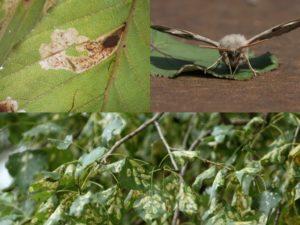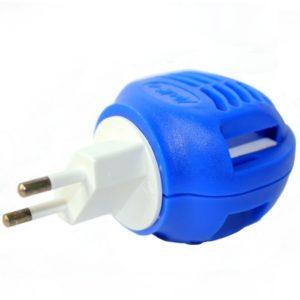Pestryanka - poplar moth, not dangerous to humans
Content
Poplar moth (pestryanka) is a nocturnal pest that actively spreads during the flowering of poplar. Together with down, the insect enters apartments, houses, cottages, where it begins to parasitize. It will not be possible to completely destroy the moth, but it is possible to regulate its numbers using preventive control methods.
What does poplar moth look like (photo)
Features of poplar moth
Name: Poplar tender-sided moth
Latin: Phyllonorycter populifoliellaClass: Insects - Insecta
Squad: Lepidoptera - Lepidoptera
Family: Moth moth - Gracillariidae
 | Habitats: | garden and park |
 | Dangerous for: | poplars, apple trees, plums |
 | Means of destruction: | pesticides, in the home folk methods |
Poplar moth is considered a household and agricultural parasite. Insect larvae are extremely voracious.
With their massive invasions, leaves are shed from poplars and, as a result, the tree dies. To understand how to deal with this pest, you should know its features.
Appearance, adaptation
Pestryanka belongs to the Poplar family, a subspecies of the Butterfly. It got its name from the motley mottled pattern on the brown forewings with velvety edging.
The hind wings are somewhat shorter than the front wings, painted in a calm steel color. Due to the camouflage color, the insect is invisible to enemies against the background of trees. The length of the wing of an adult is approximately 7-8 mm, the span is up to 10 mm.
The moth larva reaches a length of 5 mm, has a light yellow color. As it develops, it changes color, acquiring a brighter orange hue.
In autumn, along with leaf fall, cocoons with moth caterpillars can get into the ground, where they wait out the cold season.
Cocoons can winter not only in the ground, but also in the bark of trees, cracks and crevices of houses and other human buildings. With the advent of heat, insect activity resumes. They fly out of their shelters, the mating period begins.
Habitat
Under natural conditions, the parsley is often found in the countries of Central Asia (Uzbekistan, Kazakhstan, Tajikistan, etc.), in the Caucasus, in the European part of Russia. Areas of growth of pyramidal, fragrant, balsamic poplar actively contribute to the spread of the pest. Moth does not like wild forests.
In apartments and houses, the butterfly is attracted to electrical appliances, lampshades, chandeliers, containers with flour, cereals, dried fruits. Human housing is considered a favorable environment for their reproduction.
Lifestyle and nutrition
Poplar moth is nocturnal. During the day, she disguises herself among the foliage of trees, hides in secluded corners of a house or apartment. At night, the moth revives and flies into the light.
If winter caught insects outside the city, then their larvae hide in fallen leaves or bark of tree trunks.
Life cycle and reproduction
The poplar pest does not live long - only 3 days. During this period, a sexually mature individual, under favorable conditions, is able to lay 2-3 eggs. Often, the moth lays its eggs in poplar fluff, which is considered a favorable breeding ground.
Harm from poplar moth
The insect greatly harms green spaces - poplar, maple, aspen, fruit trees, flowers. In order to feed themselves and prolong their kind of poplar moth invasion, they destroy the foliage of trees, which leads to their death. Pestrianka is listed as an insect pest, along with bark beetles and mites.
Moths are safe for human health. Food is not interesting for her, she cannot become a carrier of diseases, like flies, rats, mice. The insect is indifferent to clothes, fur shoes. May cause allergic reactions in people who are prone to it.
The moth in the apartment is annoying with its presence, it can leave dark marks on the furniture, which are poorly eliminated. In large quantities, it clogs into lighting fixtures, televisions, computers, household electrical appliances, where it lays eggs. This puts expensive devices out of action.
Does poplar moth bite
The winged pest does not pose a physical threat to humans and pets. The main task of sexually mature moths is mating and egg-laying. Her mouth apparatus and digestive organs are undeveloped. She cannot bite a person.
Ways to fight in the apartment
Effective pest control methods in an apartment or in a house can be considered:
- mosquito nets on windows to prevent penetration into the dwelling;
- mechanical processing of places of accumulation with a household vacuum cleaner;
- poisonous sprays from flying insects.
When using toxic drugs, care should be taken and strictly adhere to the instructions for use.
Types of funds
To destroy harmful insects in their home, everyone selects a remedy at their discretion. It could be:
- the use of electric fumigators;
- spraying aerosols with enteric-contact or paralytic insecticides, such as Mosquitoll, Reid, Dick 3;
- the use of traps with a sticky base to catch adult caterpillars.
Folk methods
You can scare away butterflies at home using folk remedies:
- laundry soap;
- tangerine peels;
- lavender oil;
- geranium;
- wormwood;
- garlic;
- tobacco, etc.
Destruction of butterflies on the street
The following are considered environmentally safe methods of dealing with poplar moths used on the street:
- autumn destruction of old fallen leaves;
- attraction to the site of entomophages (rider beetles) used as food for adults, larvae and moth ovipositions;
- inspection and manual removal of infected leaves;

Poplar moth larva.
- the use of special sticky traps;
- flush;
- use of spring plant oil to repel insects;
- the use of non-woven material to cover low-growing crops (cucumbers and flowers) in order to prevent reproduction;
- sanitary pruning of tree crowns;
- replacing poplars with trees that are unattractive to this pest.
In some cases, the use of chemicals is indispensable:
- Spraying the trunk, crown, near-stem territory with pesticides (karbofos). It is aimed at the destruction of larvae; this poisonous substance does not act on adults and pupae. A prerequisite for the use of toxic substances is the observance of safety regulations.
- The use of paraffin-based products that negatively affect not only the larvae, but also the eggs of the moth.
- The use of ecological preparations made from plant materials - pyrethrum (from Dalmatian chamomile). Weekly treatment of affected trees is required.
In case of mass infection of poplars with parsley, they are completely cut down.
Conclusion
Pestrianka, eating plant food, under favorable development conditions for it, can cause great damage to a person. The insect has chosen poplars and a number of trees located next to them, not averse to settling in a human dwelling.
Knowing different pest control methods and knowing how to use them properly indoors and outdoors can help control pest numbers and reduce harmful impacts.



